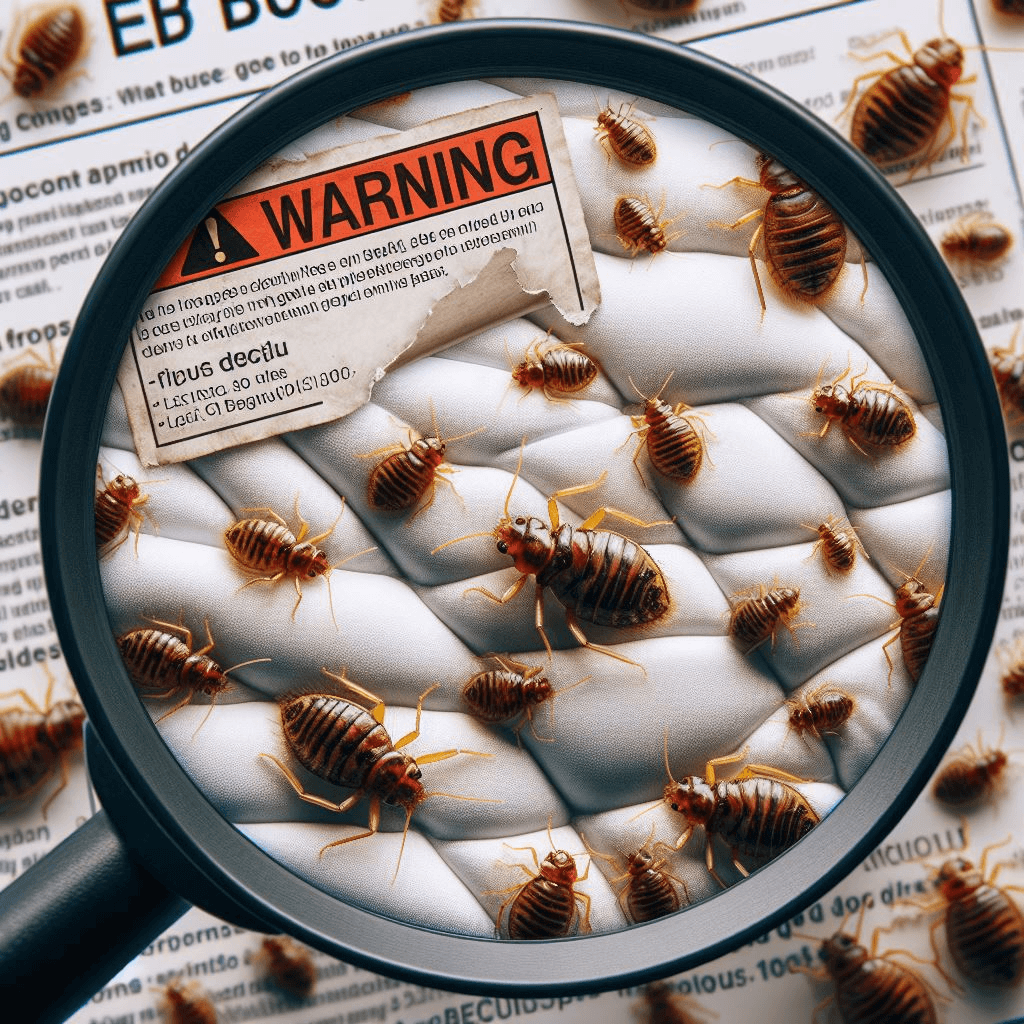Uninvited Roommates: Bed Bugs and Their Year-Round Resilience
Picture this: you crawl into bed after a long day, ready to rest and rejuvenate. But as you settle in, an unwelcome thought creeps into your mind—do bed bugs have a specific season?
Suddenly, the tranquility of your sleep-tight sanctuary is shattered by the unsettling notion that these pesky critters could invade our bed at any time. Bed bugs (Cimex lectularius) are blood-sucking insects that have been making an unwelcome comeback in recent years.
Once nearly eradicated in developed countries, these minuscule intruders have found ways to hitch rides on unsuspecting victims and establish new infestations across the globe. While many people associate them with dingy motels or unkempt homes, the truth is that these resilient pests can be found anywhere humans rest their heads: mattresses, box springs, college dorms, office buildings—you name it.
The prevalence of bed bugs continues to spread due to several factors. Increased international travel has allowed these tiny hitchhikers to traverse continents with ease.
Additionally, a decline in the use of certain pesticides and the development of insecticide resistance among bed bug populations have made it more difficult to eliminate infestations. As a result, we need to understand their behavior patterns.
One common belief about bed bugs is that they have a specific season during which they are most active or when infestations are more likely to occur. However, this notion may not hold when it comes to these persistent pests.
While seasonal changes can influence their activity levels and behavior to some extent, bed bugs are not limited by any particular time frame—they can strike at any moment throughout the year. Stay tuned as we delve deeper into the mysterious world of bed bugs continue their bug behavior and uncover the truth about their alleged seasonal preferences.
We will explore the factors influencing their activity, dissect the presence of bed bugs in different seasons, and even reveal some rarely known facts that will leave you pondering their year-round resilience. So, let’s begin our journey into the world of these elusive insects and uncover what lies beneath the surface of those itchy bed bug bites!
Empower Yourself with Knowledge: Visit Bed Bug FAQs for a comprehensive collection of answers to commonly asked questions about bed bugs. Expand your knowledge and tackle bed bug issues with confidence.
Overview of Bed Bug Behavior
A Sneaky and Persistent Pest
When it comes to bed bugs, understanding their behavior is crucial in combating them effectively. These tiny, blood-sucking pests have a well-defined life cycle that consists of multiple stages.
From egg to nymph to adult, bed bugs follow a predictable pattern of growth and feeding. Bed bugs typically hide during the day in cracks and crevices near their food source – us!
At night, when we are peacefully asleep, they emerge from their hiding spots to feed on our blood. They are attracted by the carbon dioxide we exhale as we sleep and use heat sensors to locate us with eerie precision.
A Life Cycle Full of Surprises
The life cycle of a bed bug begins with an egg, which is roughly the size of a pinhead and barely visible to the naked eye. Female bed bugs can lay hundreds of these tiny white eggs over their lifetime. These eggs are commonly found in mattress seams, furniture crevices, or any other hiding spot close to their hosts.
After about a week or so, these eggs hatch into nymphs – immature bed bugs that resemble miniature versions of adults but are nearly translucent. Nymphs require regular blood meals in order to molt and progress through five molting stages before reaching adulthood.
Interestingly enough, bed bug nymphs can survive for weeks without feeding if necessary. This remarkable adaptation allows them to hide away in one location until they sense favorable conditions – usually when humans return after being away for some time.
Survivors Against All Odds
One aspect that makes bed bugs such formidable pests is their ability to survive various s environments. While they prefer temperatures between 70-80°F (21-27°C), studies have shown that they can endure both extreme cold and heat for short periods.
Extreme cold temperatures can kill bed bugs, but they are surprisingly resistant to low temperatures. They can withstand freezing conditions for days and even survive short exposures to temperatures as low as 0°F (-18°C).
On the other hand, bed bugs are also resilient in non-extreme conditions. They can tolerate a wide range of temperatures, from around 46°F (8°C) to 113°F (45°C), provided these conditions remain a constant temperature throughout.
This adaptability allows them to infest a variety of environments, including homes, hotels, dormitories, and even public transportation. In addition to temperature variations, bed bugs can also survive for several months without feeding.
Their ability to go into a state of semi-hibernation known as “diapause” enables them to endure starvation and persist in hiding until another feeding opportunity arises. Understanding the behavior and resilience of bed bugs is crucial in developing effective strategies for prevention and eradication.
These pests may be sneaky and persistent, but armed with knowledge about their life cycle and survival tactics, we can better protect ourselves against their unwelcome presence. Remember – sleep tight, but don’t let the bed bugs bite!
Factors Influencing Bed Bug Activity
The Dance of Temperatures and Humidity
Ah, the delicate tango between bed bugs and their environment! These pesky critters are quite sensitive to changes in temperature and humidity levels. You see, bed bugs love cozy, warm places like our beds, where they can find an indulgent feast on our unsuspecting flesh.
But they also thrive in humid conditions, as moisture helps them survive and reproduce. When temperatures soar during the summer months, bed bug activity tends to ramp up as well.
They become more active and seek out new sources of nourishment with increased vigor. The warmth not only encourages their growth but also accelerates their reproductive cycle.
Bed bugs multiply in numbers faster than a rabbit on steroids! On the flip side, when the mercury drops during winter’s icy grip, these blood-sucking pests tend to slow down a bit.
Cold temperatures make them lethargic; they retreat into a state of relative dormancy known as diapause. It’s like they take an extended nap while we shiver under piles of blankets.
The Seasonal Symphony of Reproduction and Feeding Patterns

Seasons play a vital role in shaping the reproductive and feeding patterns of these miniature vampires. As spring breathes life into nature after its long slumber, it also wakes up the dormant bed bugs from their winter snooze.
Spring is notorious for being a prime time for infestations to flourish—it’s like open season for these little pests! During springtime, food sources become more abundant as humans spend more time outdoors or travel more frequently.
Bed bugs seize this opportunity to hitchhike their way into our homes by latching onto our belongings or even ourselves! So be extra cautious when venturing into public spaces during the bed bug season.
However, let’s not forget about fall—the overlooked transitional period for bed bugs. As summer winds down and people return from their vacations, these sneaky creatures may find themselves without a blood buffet.
This apparent scarcity can prompt bed bugs to become more desperate, seeking new harborage sites or exploring new rooms within our homes. So don’t rest easy just because you think bed bug season is over!
Temperature and humidity levels undoubtedly impact the behavior of bed bugs. Warm temperatures and higher humidity serve as catalysts for their rapid reproduction, making spring and summer prime seasons for infestations to thrive.
Conversely, colder temperatures during winter cause a lull in their activity, but they don’t disappear entirely! So keep your guard up year-round because when it comes to bed bugs, there’s no time for complacency or snoozing!
Bed Bugs in Different Seasons
Spring: A Bountiful Season for Bed Bugs
As spring break, the temperature rises and flowers bloom, nature awakens from its slumber. Unfortunately, this rejuvenation also extends to bed bug activity. Spring is notorious for marking an uptick in bed bug infestations, making it a peak season for these resilient insects.
But why is that? Well, there are a couple of factors at play here.
Firstly, warmer weather creates the perfect conditions for bed bugs to thrive and reproduce. These blood-sucking pests breed more rapidly when temperatures rise above 70°F (21°C), which is often the case during springtime.
Additionally, humans tend to travel more frequently during this season, unknowingly becoming unwitting carriers of these pesky critters. Another reason behind the surge in springtime infestations is that bed bugs possess an uncanny ability to hide and remain undetected.
They are masters at concealment, effortlessly lurking within mattress seams or even behind wallpaper until their next blood meal opportunity arises. Thus, by the time spring arrives and people start noticing bites or other signs of infestation, the problem may have already reached advanced stages.
Summer: Bed Bug Bonanza
Ah, summer—the season of sun-kissed skin and carefree vacations. But amidst all the blissful moments lies a potential threat: increased bed bug activity.
With temperatures soaring high and hordes of people flocking to tourist destinations or staying in college dorms with varying hygiene standards, it’s no wonder that summer vacation becomes a prime time for these insidious insects. During summer vacations, hotels experience a heightened turnover rate as visitors come and go from different corners of the world.
This constant flux exposes unsuspecting travelers to unfamiliar environments where bed bugs can hitch a ride on luggage or clothing before settling into their new location. Public transportation, such as planes or buses, can also inadvertently facilitate the spread of these unwanted stowaways.
To find bed bugs and prevent a summer infestation nightmare, vigilance becomes paramount. Regularly inspect suitcases and clothing for any signs of bed bugs after returning from trips.
Launder clothes with hot water and dry them on high heat to effectively kill any potential hitchhikers. These precautions can help you escape the clutches of a relentless bed bug invasion during the sunniest time of the year.
Fall: Transitioning Weather, Resurging Bed Bugs
As leaves change color and temperatures begin to cool, fall ushers in a transitional period for bed bugs. After the busy summer travel season, people unknowingly return home carrying these pests.
This migration back to familiar spaces creates opportunities for bed bugs to spread within communities. During this season, it’s important to remain vigilant and employ preventive measures to avoid a resurgence in infestations.
Inspect your bedding regularly, paying attention to seams and crevices where bed bugs often hide or lay eggs. Consider encasing mattresses and box springs with protective covers designed specifically for deterring these resilient insects.
Furthermore, if you suspect an infestation in your home or find any signs of bed bug activity, don’t hesitate to contact professional pest control companies equipped with the expertise required for effective eradication. Taking swift action will help prevent these unwelcome guests from settling comfortably into your living room or space as fall settles in.
Winter: A Relative Lull
While winter may bring shivers down our spines due to cold weather, it does offer some respite when it comes to bed bug activity offers some respite regarding. As temperatures drop significantly during this season, so do their reproductive capacity and overall activity levels.
However, it’s important not to misconstrue this decrease as complete elimination. Bed bugs are tenacious creatures that can survive in temperatures as low as freezing for extended periods.
They enter a state of hibernation-like dormancy, known as diapause, during which their bodily functions slow down, making them less active. Nevertheless, it’s crucial to remain cautious and continue preventive measures even during the colder months.
Keep an eye out for any signs of bed bug infestation and maintain regular cleaning habits. Inspect cracks and crevices where these pests often seek shelter, such as baseboards or furniture joints.
By staying proactive throughout the year, you can minimize the risk of a winter awakening that could turn into a full-blown bed bug infestation. Remember, vigilance remains the key to combating the bed bug problem or bugs regardless of the season.
Insight into studies suggesting that indoor heating may disrupt seasonal patterns
While it is widely known that bed bugs are more active during certain seasons, recent studies have raised intriguing questions about their behavior in indoor environments. One fascinating finding suggests that the prevalence of indoor heating can disrupt bed bugs’ traditional seasonal patterns.
Typically, bed bugs are believed to thrive during warmer months and become less active in colder weather. However, with the advent of central heating systems, the comfort of our cozy homes can create an artificial environment that blurs these distinctions.
Research shows that indoor heating can inadvertently extend the activity period for bed bugs beyond what would be considered their natural season. The steady warmth provided by heaters throughout the year allows these resilient pests to continue breeding and feeding without interruption.
As a result, households may face year-round infestations rather than experience a decline during the colder months. This insight challenges previous assumptions about bed bug behavior and highlights the importance of understanding how human-modified environments can influence their seasonal dynamics.
Discussion on how localized climate variations can affect regional trends
Understanding localized climate variations is crucial when examining regional trends in how bed bugs spread and bug infestations. While there may not be an “official bed bug season” per se, different geographic locations experience distinct conditions that influence these pests’ behavior.
Factors like temperature, humidity levels, and climate fluctuations play significant roles in determining regional patterns of infestation. Bed bugs have ample opportunities to thrive all year round in areas with milder climates or relatively consistent warm weather throughout the year, such as tropical regions or parts of California.
However, regions with more pronounced seasonal changes may witness fluctuations in infestation rates according to local climatic conditions. For instance, areas with cold winters might experience a decrease in reported cases during this time due to decreased reproductive activity and movement.
However, it is important to note that bed bugs can survive in colder temperatures and remain active in heated residences. Therefore, while the number of reported infestations may decrease during the winter months, it does not mean that bed bugs have disappeared entirely.
Overall, understanding localized climate variations is essential for effective pest control efforts. By considering the specific conditions of a region, pest control companies and individuals can adapt their strategies accordingly and take timely preventive measures to combat these resilient pests.
The Ever-Present Bed Bug Challenge

Despite the absence of a clear-cut “bed bug season,” these persistent parasites continue to pose a challenge throughout the year. Their ability to adapt to indoor environments and withstand various climatic conditions makes them formidable opponents in the battle against infestations.
Combining this knowledge with vigilant prevention methods is crucial for maintaining a bed bug-free home, regardless of seasonal variations or climate peculiarities. Remember, bed bugs are master hitchhikers who can travel on clothing or infest items carried on public transportation.
Their tiny white eggs can be easily hidden within cracks and crevices of furniture, mattresses, and box spring, or even within the seams of clothing. Therefore, irrespective of seasonal changes or regional trends observed in infestation rates, it is vital to adopt proactive measures such as regular inspections, maintaining cleanliness in living spaces, sealing potential entry points around windows and doors, using protective covers on mattresses and box springs, and seeking professional help if an infestation occurs.
So next time you hear someone claim that there’s an official bed bug season or assume they only appear during warmer months like spring or summer – remind them that bed bugs are persistent and pesky creatures that do not adhere strictly to a specific calendar season but rather adapt to their surroundings with resourcefulness unmatched by many other pests! Sleep tight – but don’t let those elusive bed bugs bite!
Conclusion: A Never-Ending Battle Against Bed Bugs
The Elusive Nature of Bed Bugs
Throughout this article, we have explored the fascinating world of how bed bugs live and their seasonal behaviors. We have learned that while bed bugs may not have a specific season, certain times of the year do see an increase in their activity. Spring brings warmer weather and triggers a surge in infestations, summer sees heightened travel facilitating their spread, fall presents a transitional period, and winter offers some respite but does not eliminate the pests entirely.
Stay Vigilant to Combat Infestations
It is crucial to remain vigilant against new infestations of these persistent creatures. Their ability to survive in various environments and their knack for hitching rides during international travel means that new infestations can occur at any time of the year. Regularly inspecting your sleeping areas, including your bed frame and mattress seams, for signs of bed bugs or their tiny white eggs is essential to catch an infestation early on.
Professional Help and Preventive Measures
In our never-ending battle against bed bugs, it is prudent to seek assistance from pest control companies experienced in eradicating these pests. Their expertise can ensure a thorough inspection and effective treatment if an infestation of common bed bugs occurs. Additionally, implementing preventive measures such as using mattress encasements, reducing clutter around sleeping areas, and practicing good hygiene habits can go a long way in deterring bed bugs from infiltrating our homes.
A Positive Outlook for Restful Nights
While the presence of bed bugs may seem disheartening, it is important to remember that with proper awareness and action, we can minimize their impact on our lives. By staying informed about seasonal trends in bed bug control and taking proactive steps to prevent infestations or address them promptly when they occur, we empower ourselves against these resilient pests. So, rest easy and sleep tight, knowing that with our knowledge and determination, we can reclaim our homes and ensure peaceful nights free from the annoyance of bed bugs.
Choose D-Termination, the premier pest control service in Las Vegas, to conquer bed bugs!

Are you currently dealing with a bed bug problem in Las Vegas? Don’t worry, because D-Termination is here to assist you. Our expert team specializes in eliminating bed bug infestations and restoring comfort to your living space. Bid farewell to bed bugs by choosing D-Termination for effective pest control today!
To book your bed bug control service and reclaim your space from these persistent pests, contact us at 702-919-6310 or visit dtermination.com.
Frequently Asked Questions:
Bed bug infestations tend to be more prevalent and severe regardless of the time of year.
Bed bugs are generally nocturnal but may come out to feed during any part of the day if they are hungry and the environment is conducive.
Bed bugs become less active or inactive at temperatures below 50°F (10°C), and their activity significantly decreases as temperatures drop further.
Bed bugs can survive in winter, but their activity may decrease as they seek shelter and warmer areas. They can persist in indoor environments with suitable conditions.
If you found this article enjoyable, you might also find the following related content worth exploring:
The Stealthy Hitchhikers: Unveiling the Connection Between Bed Bugs and Pets








